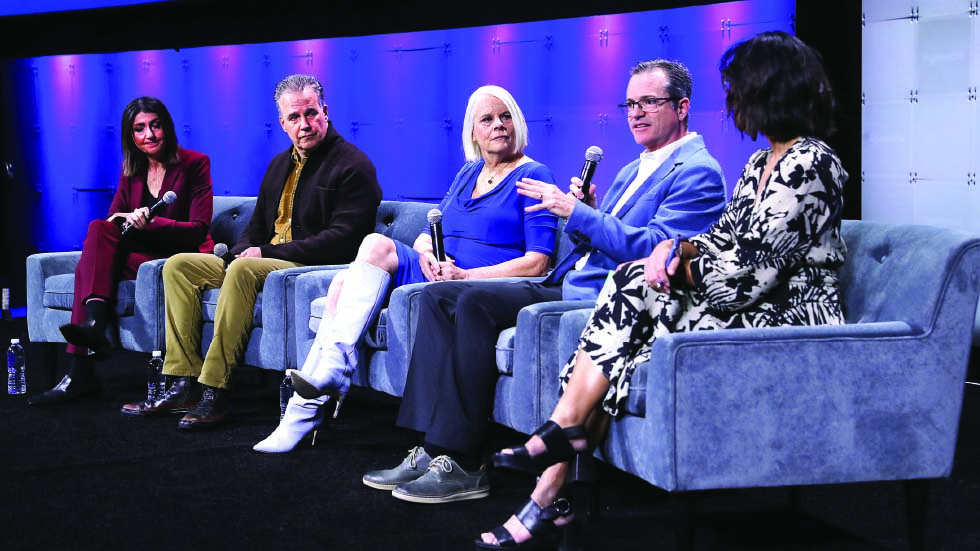2025 NAB Show: In Developing Procedurals, Characters Matter
Executives behind CBS’s ‘Fire Country’ say compelling protagonists keep viewers invested

The procedural show on broadcast television isn’t a new concept, but, according to the team at CBS, audiences are craving the long-term investment in characters that a limited series on streaming services can’t compete with. This was the focus of the panel “ ‘Fire Country’ and the Boom of Broadcast Procedurals (Again!)” at NAB Show on Sunday.
Broadcast procedurals like “CSI: Crime Scene Investigation” and “NCIS” have long focused on the satisfying formula of problem, investigation and solution, typically in a 42-minute fashion. But in the age of streaming giants pulling audiences away from linear television, procedural producers, like “Fire Country” co-creators and executive producers and panelists Joan Rater and Tony Phelan, have found that investing in character development is the best way to keep audiences drawn to shows.
“Everybody can relate to redemption stories and the need for second chances,” said Rater of her show, “Fire Country,” where a convicted felon fights fires to reduce his prison sentence in his small hometown — a notable break from the norm of big-city dramas.
“[The show] is aspirational in terms of family and community and that, I think, has really resonated with people,” Phelan added. Both creators agreed that, now more than ever, writing characters that audiences tune in to see every week, for upwards of 20 episodes a season, is the main focus of building out these shows.
The actual procedure of the procedural isn’t why audiences resonate with CBS shows. Rather, Bryan Seabury, executive vice president, head of content strategy and drama development at CBS Studios, asks himself if the show is built “to go the distance.”
“Other shows … they’re limited, they’re designed in a different way,” Seabury said. “Here, the questions we ask in a pilot are much more open-ended and hopefully, you’re planting seeds that go for seasons.”
Week after week, audiences can identify with these characters as they invite them into their homes, and in some ways, become part of the family, as Phelan put it. The writers can push the bounds of storytelling by allowing characters to grow, experience setbacks and change over a more authentic timeline, rather than in eight episodes, according to Rater.
Get the TV Tech Newsletter
The professional video industry's #1 source for news, trends and product and tech information. Sign up below.
Though differentiating themselves from streaming services, the CBS panelists couldn’t ignore platforms like Netflix, which offer viewers binge-able content at a clip. However, Yelena Chak, executive vice president, scripted development at CBS Entertainment, found that Netflix can be used as a promotional tool.
“The people who found it on Netflix, they watched the first season there, which then drove them to Paramount+ to watch season two, which then in turn drove them back to CBS broadcast network for season three,” Chak said. “So it brought people right back to our ecosystem.”
Seabury also noted that this era of television gives executives the ability to see ratings and viewership not only on premiere night but on delayed viewing, on the network’s streaming platform and then later, on a third-party streaming service like Netflix, which improves overall results. Case-in-point: In the month that season one of “Fire Country” was released on Netflix, 3 billion minutes of the show were viewed between Netflix and Paramount+.
The long-term strategy doesn’t stop there. In the coming months, the “Fire Country” spinoff “Sheriff Country,” which also focuses on the character development of a small-town sheriff dealing with personal and professional dilemmas, will premiere on CBS. The spinoff will not only serve as a marketing vehicle for the original show by way of crossover episodes, but panelists agreed that this spinoff is a testament to the deep character development of procedurals that keep audiences engaged with whatever universe is being created.
Copyright 2025 NAB
Alyson Trager is an editor at SmartBrief.
